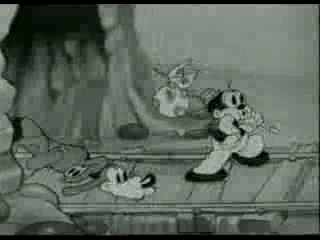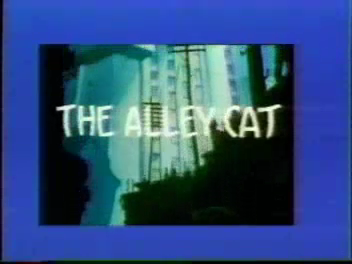
Review-Synopsis by Rachel Newstead
The Alley Cat
Release Date: July 5, 1941
Director: Hugh Harman
In short: An unlikely romance ensures between a scraggly alley cat and a Park Avenue Persian--much to the regret of a certain bulldog and a butler...
(Edited 7/08/08 to correct minor errors and to add further comments).
Foreword: Getting sick is probably the worst thing that can happen to a blogger on a hot streak, but that's precisely what happened to me.
For most of June, I not only had to struggle with a cold, but a cold in the middle of allergy season, making it doubly potent--and twice as hard to get rid of. By the time I was ready to work on the promised Landing Stripling review, I was too busy sneezing to do much writing--when I wasn't flat on my back in bed.
While I recuperated, Kevin provided some wonderful content, the most intriguing of which was his review of a Hugh Harman cartoon, The Alley Cat--a cartoon I admit to having given only scant notice before. As usual I was astounded by his memory for detail, and drawn in by his enthusiasm. His instincts are rarely wrong--after seeing this cartoon again, I knew I had to add my own observations.
The Landing Stripling review will come, of course. For now, I beg your indulgence as I give you my own take on the wonderful The Alley Cat.
Just looking at the names "Harman" and "Ising", one can be forgiven for thinking they were meant to be together--a coupling of names ordained by the animation gods.
That unlikely, unintentionally punning combination--belonging to two men noted for their skill in combining music with animated images--is a most incredible accident of fate, to be sure. We've become so accustomed to seeing those names together, it's easy to think of the two of them as a single unit, joined from birth by their drawing hands.
It's a mistake even I have been known to make, speaking of the two as if they were interchangeable. Yet Hugh Harman and Rudolf Ising, ironically, were linked only in name. They never once co-directed a cartoon--and probably couldn't have, had they bothered to try. Each had his own respective crew, and their demeanors--and attitude toward filmmaking--couldn't have been more different.
Harman was the fiery one, the one who went head-to-head with producers, distributors, and just about everyone else in an effort to improve his product. The words "good enough" were not in his vocabulary--it had to be better, and to Hugh Harman, "better" usually meant a bigger budget. Ising was the phlegmatic one, a man who very quickly earned the nickname "The Sleepy Bear"; the lethargic Barney Bear was Rudy Ising in fur.
Harman created characters--Bosko The Talk-Ink Kid might have showed Ising at the drawing board, but Bosko sprang from Harman's pen. Action meant as much to Harman as personality, perhaps more--Bosko rarely stood still, always ready to entertain, bouncing along to a steady rhythm. Ising created stories, in which the characters were often secondary to the lush backgrounds or the music. Harman aspired to be Disney, yet Ising was the most Disney-like, being most at home in the realm of the fairy tale, Walt's stock in trade. It was Ising, not Harman, who broke Disney's Academy Award winning streak with the uncannily Disney-like The Milky Way.
(Note: Kevin, of course, just couldn't resist reminding me about Ising's Two Pups. I'll concede certain points: yes, the settings were contemporary, and the timing fast--one cartoon in particular has scenes similar to The Alley Cat--but even these come across as more cute and storybookish than what Harman was doing at the same time, on the order of the early Chuck Jones. The pup's owner even had what sounds to me like a nursery-school teacher way of speaking, in the manner of one reciting a story to children--R.)
In my review of Romeo In Rhythm, I put forward the theory that Harman's style was energized by the influx of New York talent. Now, looking at Harman and Ising's contributions separately, I realize this is only partly true. Harman's cartoons, thanks largely to Bill Hanna's often-discussed timing, were always energetic--one need only look at Circus Daze, The Old House, and even the early Schlesinger Bosko musicals to see that. What the New York animators did do, however, is take Harman's cartoons out of the farmyard.
Romeo In Rhythm, as we've already seen, opens in a cornfield, but that's the only glimpse of a rural setting we'll see in that cartoon. The play-within-the-cartoon is aggressively urban, its Romeo a contemporary hipster serenading his Juliet in a mock-up back alley to the sound of swing.
Today's highlighted cartoon also takes place in an urban alley (a "real" one this time) its contemporary music sung by an audacious alley cat. While the mangy "star" of the story may lack the musical finesse of the crows in Romeo In Rhythm, he more than makes up for it in enthusiasm and pure chutzpah--an attitude that's pure New York.
The cartoon opens with a view of an "uptown" skyscraper from the perspective of a back alley, the cartoon's title superimposed over the scene. The copy I'm working from for this review has the "letterboxed" opening titles Turner was infamous for, and it does this cartoon a disservice, as it's difficult to see the painstaking detail in the backgrounds. The opening shot is still impressive, however: the camera tracks upward as it travels up the exterior of a posh Park Avenue apartment building toward the penthouse.
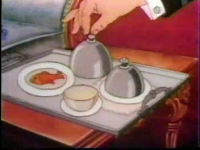
The scene dissolves to the interior of a luxury apartment; a butler, shown only from the neck down for the moment, knocks on a bedroom door carrying a tray of food. He walks though the lushly-appointed room and places the tray on a table, in close-up. He removes the tureen to reveal a plate of fish, and clears his throat as he says, "Dinner is served," m'lady!"
"M'lady", whom we expect to a be a wealthy socialite, is actually a white persian cat. She appears to sniff the fish and give it a slightly disdainful look as the butler clears his throat again and says, "Will there be anything else, m'lady?" The cat purrs "Nooo...." in a Mae West-like voice. As the butler leaves, she gives her meal another slightly disdainful glance, jumps off the sofa and walks away. The butler, meanwhile, can be seen slowly closing the door behind him--but before he does, he can't resist giving the audience a contemptuous sniff. He's clearly not happy with having to wait on a cat.
The socialite persian, meanwhile, walks over to the window and jumps on the sill--a full moon shines through. She lets out a soft purr--she's clearly bored, and is looking for a little fun.
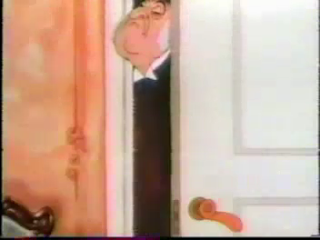
Cut to a view of the alley, where we get the first view of our alleged hero, who dances into the scene much in the same manner as Bob Clampett's "Gorgeous Hunk Of Man" in his The Hep Cat (and even looks as if he could be a close relative to Clampett's cat). He jumps onto a crate, then onto a fence as he rummages through a nearby trash can. He prepares to eat the remains of a fish when he spies the uptown persian walking back and forth on the balcony of her luxury apartment. She idly sniffs the flowers planted along the edge.
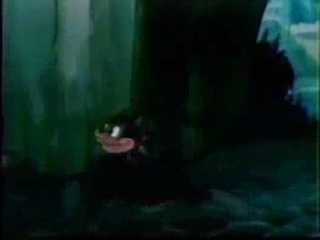
Cut to the alley cat, who's clearly impressed. "Oh, boy! Hi, baby!!" he yells at her in a voice vaguely reminiscent of Clarence "Ducky" Nash (though it's not, despite what the IMDB says--more on that later.)
The persian turns her back to the alley cat--for the briefest instant, we're led to believe she's going to snub him, as befits a cat of her position, but as we cut to a close-up, she looks over her shoulder and enticingly says "Hello...."
Scott Bradley's music swells and the alley cat starts to "sing" (if you want to call it that) the 1937 musical number "That Old Feeling":
I saw you last night and got that old feeling....
Cut to an aerial shot of the high-class feline on her balcony, who's suddenly more humanized--she meows her response to the alley cat's song as she paces back and forth along the balcony on two legs. As she half-meows, half-sings, she clutches her paws to her chest in a slightly exaggerated "romantic" gesture. Cut to the alley cat who sings the next line while his lady love continues to meow along from off-camera--he's clearly singing words, but at least on this copy of the cartoon, they're no more understandable than the female cat's meowing.
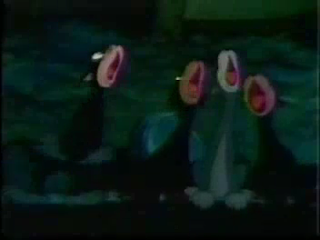
The alley cat's joined on the fence by three of his buddies, who meow and purr along in close harmony. They clearly have the talent our hero lacks, since this is perhaps the most entertaining scene in the picture.
The butler, however, doesn't seem to think so, since he comes out on the balcony and shouts at the cats to "Stop that bloomin' noise!", clamping his hands over his ears. Naturally, he's ignored--the butler yanks the curtain shut, making us think for a moment he's resigned to the racket.
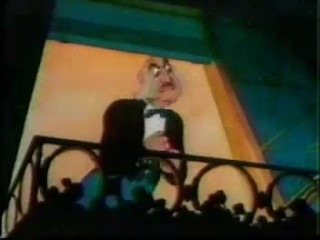
Not quite--as we cut to the interior, we see the butler turn and shout as he stalks down the corridor, "Rover! Rover! Wake up, Rover! Cats!" It's actually quite a nice shot, as the figure of the butler moves closer to the camera as he walks down the corridor, to the point that only his legs are revealed. It's almost like a SteadiCam shot.
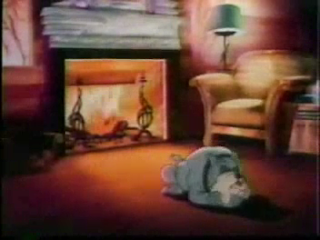
"Rover", whom we see for the first time in the next scene, is awakened from his nap by the butler's off-camera shouting. He groggily rises, the jumps up as if hit by an ember from the nearby fireplace. He runs toward the door at full speed, but neglects to notice it's still closed, and rams straight into it. The butler comes into view, if only from the waist down, and opens the door yelling "Rover! Get him!!" What follows is a rather impressive "speed" shot of the dog barreling down the stairs so quickly, the momentum causes him to run down the side of the bannister. This scene looks vaguely familiar, and given Harman's penchant for re-using animation, it's quite possible this scene was cribbed from a Bosko cartoon. (If memory serves, there's a similar scene involving Bruno in The Old House).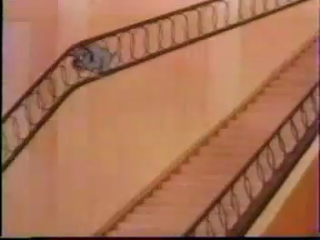
Cut to exterior view--we next see the bulldog as he bursts through the front door and toward the camera. The alley cat's three backup singers scatter as the dog approaches, but our hero isn't afraid of him. In fact, the dog's more afraid than anyone, as he skids to a halt and freezes with his hindquarters in an arched position when the alley cat slashes his claws at him.
Suddenly remembering what he's there to do, the bulldog tries to assume a more threatening pose and scare the cat away. Ah, but pampered pooch that he is, he's a bit out of practice: the sound that comes from his mouth is more like that of a toy poodle than a big, bad bulldog. (The more observant may remember that barking sound as the sound the trout make in the Barney Bear cartoon THE FISHING BEAR. Barking fish? Well...you'd have to see it to understand...)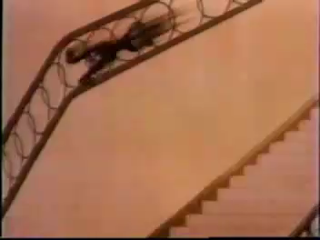
The embarrassed bulldog tries to clear his throat as the alley cat, now standing on two legs, laughs at him from offscreen. "Tough guy, eh?" the cat remarks.
The bulldog makes a leap at the alley cat from the bottom of the frame. Having recovered his voice, he makes a rather menacing growl as he snaps at the cat and misses. There's something familiar about that sound, too, but I'd rather not get too far ahead of myself at this point. The cat merely hisses at him and jumps down on the other side of the fence.
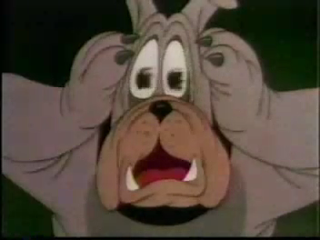
The bulldog sniffs around until he comes to a knothole in the fence. Peering through it, he fails to see another knothole right by his rear end--you can pretty much guess what's going to happen here, since our friend the alley cat's on the other side. Sure enough, we see the cat standing on the other side of the fence, preparing to menace the poor unsuspecting bulldog. He grabs an old eggbeater from the trash and proceeds to aim it through the knothole right at the dog's behind. He gooses the dog with it--as the dog flips around, he shoves the eggbeater through the other knothole and gooses the dog again--this action gets repeated several times until the dog gets dizzy--a closeup shows his eyes rattling around in his head.

Once the bulldog regains his senses, he thinks he's figured out the situation and puts one paw over the knothole on the right, then another paw on the left one. But the camera pans back to reveal the alley cat merely lounging on top of the fence, eyeing the bulldog with an amused expression. He grabs an old light bulb from the trash can in front of him and drops it on the dog's head. The dog is startled as the bulb shatters, sending him running to the safety of his doghouse. Returning his attention to the classy girl cat, the alley cat remarks, "You ain't seen nothin' yet, baby!!"

Grabbing a bottle of ammonia from the trash, he pours the bottle into a spray gun (called a "Flit" gun, since spray guns of that type were once used to dispense an insecticide called "Flit."). We see a long shot of the cat from one corner of t he doghouse as he marches toward it, Flit gun in hand. He knocks on the doghoouse and says to the still-covering dog, "Well, well, does little Rover want to come out and play??" The cat then pulls on the dog's nose and jabs him in the eyes Three Stooges-style--but it looks a good deal more painful here than it does when Moe does it to Curly.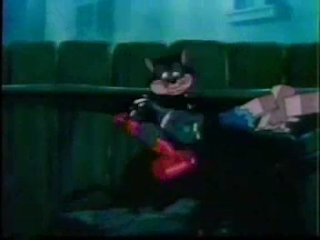
The cat marches out into the middle of the yard shouldering his Flit gun like a rifle, and tests it while he waits for the dog's inevitable attack. He doesn't have to wait long--the dog lunges at him, but in mid-air, he gets a snootful of atomized ammonia, sending him dropping to the ground like a rock.
This only momentarily dazes him, though; he lunges again and gets a much stronger dose. Now it takes a little bit longer to come to his senses--his ears flutter like wings in a very cartoony fashion as he exhibits a stupefied grin. He doesn't get a chance to make a third lunge, as the cat hits him with another facefull before he can jump. The third time proves to be the charm, freezing the poor dog like a statue--all the cat needs to do is tap him to send him toppling over.
The cat does a little self-congratulatory victory dance as we cut to the object of his affection admiring him from above. This is clearly her kind of guy--she meows "Come up and see me sometime..."
Strangely, while she cops Mae West's tagline, she's lost the Mae West-like voice she had in the first two minutes of so of the cartoon. She now sounds, for no apparent reason, like an exact duplicate of the alley cat, which to me seemed a bit strange. Is this her way of expressing admiration (or as Kevin half-jokingly put it in his review, an indication that she's in heat?) It prompted quite a bit of discussion between Kevin and me; I'm forced to conclude that while Harmon may have indeed wanted to indicate a change in the cat's mood, but it seems more likely he was rushed, and couldn't get the original voice artist when he needed her--so he relied on the fellow with the Donald Duck-imitation voice for that one brief scene, thinking it might come across as funny. As Harman is no longer alive to ask, I suspect that'll remain a mystery.
Meanwhile, our alley-cat protagonist goes wild over the classy female's invitation--he too undergoes a temporary voice change, yelling "Yahoo!" in a voice similar to Tom's whenever Tom was excited or in pain. As I recall from the Tom and Jerry Spotlight Collection sets, that voice was provided by Bill Hanna--an effect which makes this seem at times more Hanna-Barbera and less Harman-Ising. But the Harman touches are still there, as in the sudden, out-of nowhere burst of speed the alley cat exhibits in his excitement. He hops on a fence, zips up a telephone pole, and speeds along a telephone wire toward the luxury townhouse where his love awaits, all to the sound of sirens--not all that different from Harman's Swing Wedding (the Stepin Fetchit frog exhibits a similar and all too temporary burst of speed, also to the sound of sirens).
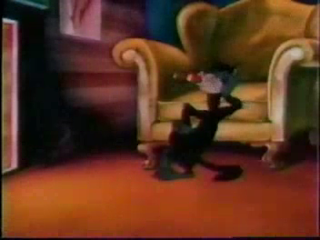
Cut to a shot of the female cat as a black blur zooms by her, leaving her to stare at the audience with a stunned expression. In the following scene we see the alley cat, in the same cozy living room the bulldog had been, lounging on the floor brazenly smoking a cigar. Exhibiting even further gall, he calls to the female cat as she passes by him, "Say, what's cookin', sister?" Since love is apparently not only blind but deaf, the female cat ignores this rather crude come-on and walks over to the radio. As Latin music comes over the airwaves, the alley cat decides to get in the spirit of things by taking the lampshade from a nearby lamp and converting it to a nifty blue sombrero. He dances toward the camera, then the scene changes to reveal both him and the female cat in medium shot as they dance together.
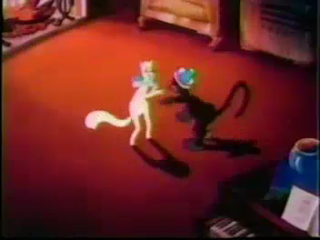
The alley cat dances toward the fireplace, but gets a bit too close--his tail catches on fire, in a couple of quick cuts, he zips out of frame, past the female cat, and toward a fishbowl, in which he extinguishes the flaming appendage. The bowl's stuck to his rear, though--a fish swims by and gives him a confused look. The cat yowls and jumps out of frame, landing next to the female cat and going through all manner of samba-like gyrations as he tries to remove the bowl--without missing a beat of the music.

In the meantime, the bulldog, only now aroused from his ammonia-induced stupor, hears the commotion going on from inside. With a rumbling growl he scrambles out of the frame toward the entrance.
Cut back to inside: the alley cat's still trying to get the bowl off himself, pounding on the floor in frustration, then leaping into the air. The bulldog appears just as the alley cat is about to land, and the dog ends up having the fish bowl broken over his head as the cat drops right on top of him. The alley cat stands there for a moment as the dog, sprawled on the floor, starts to growl--the cat pokes his head in like a lion tamer sticking his head into a lion's mouth. When he stares at the razor-sharp teeth and realizes his nemesis is back, the cat says "Uh-oh!" and speeds off to the left of the screen. We briefly cut to a view of him zipping around the corner with the bulldog in close pursuit. The momentum causes books from the bookshelves to whirl around in their wake.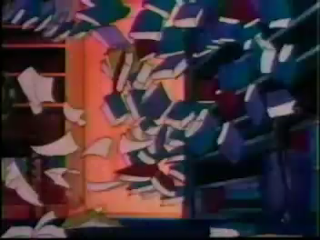
They come to a corner, but instead of going around it, they go through it, knocking out a good portion of the wall. We cut to a long shot of them in the library--the cat jumps up onto a conveniently-placed lamp, while the dog runs so fast the momentum sends him up the wall and onto the ceiling (and that, students, is an example of centrifugal force).
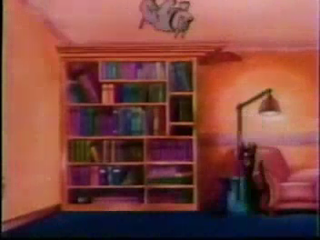
The confused dog, of course, stops while upside-down on the ceiling and after remaining suspended there for a second or so, drops to the floor--the chase continues. The dog, who has for the moment lost track of the alley cat, stops in front of a suit of armor, which the alley cat just happens to be hiding in. He sends the right arm, which is holding a mace, down on the dog's head, followed closely by another hit and a poke in the rear with a sword. The dog of course attacks the suit, sending a shower of metal parts toward the camera. As anyone who's seen The Old House knows, this is a classic Harman "money shot"--a bolt flies so close to the viewer that it takes up the entire frame (much as the skull in The Old House had done).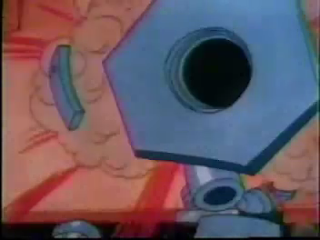

The smoke clears to reveal the dog wearing the remnants of the armor. The cat merely goes to the fireplace in the living room and...you guessed it. He opens the helmet, which is stuck on the dog's rear, and dumps in a shovel of hot coals. The pain from the dog's glowing red posterior sends him leaping through the ceiling. The butler, meanwhile, yells "Rover! Rover!" looking around frantically. He soon learns where the dog is, as the dog lands right on his head. The bulldog merely proceeds to run--still on top of the poor butler--and gets caught in the butler's clothing, in the process revealing the servant's very un-butler-like red flannel underwear.
The chase goes on, up over walls and around corners--hunks of plaster get gouged out of the walls as the speed past. The dog, running up to a mirror, crashes through both it and the wall behind it. In the meantime, the alley cat has found the laundry chute--he opens it, sending the bulldog sliding down into the laundry room below. The cat then rushes down the stairs toward the basement (in a repeat of the "running down the stairs" footage from earlier in the cartoon) to meet the dog as he hits the bottom.
The alley cat pushes the washing machine in front of the laundry chute as the dog comes through. While the poor dog is being pummeled by the plungers inside the washer (it's a slightly more advanced version of the one Cap used in Blue Monday) the butler runs past the camera and chases the cat with a broom, yelling "Why you...just let me get me 'ands on you..."
Speaking of Blue Monday, the scene following looks as if it were taken directly from that cartoon, if a little faster than that version. The butler chases the alley cat in one doorway and out another in an endless circle, fast enough to create what looks like a swirling vortex. The butler finally wises up and stops between the two doors, waiting with broom in hand for the cat to emerge. The cat does, but the butler is a little too slow, missing every attempt to bash the cat with his broom.
The cat runs into what looks like a music room, skids and doubles back toward the butler. The dog, who by now has been released from the dreaded washing machine, now chases the cat around and around between the two doorways, rendering the poor butler dizzy as he tries vainly to swat the cat. (The scene is a repeat of the earlier one with the bulldog--we see the butler in closeup as his eyes spin around and around in his head). The butler, trying to make sense of the swirling mass around his feet, brings his broom down on the first thing he can--and it turns out to be the wrong thing. He hits the poor bulldog square on the head.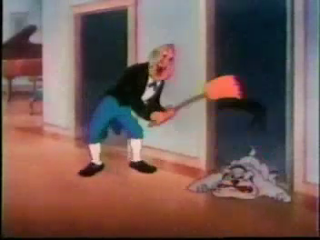
The dazed dog shakes his head as he comes to, and gives the off-camera butler a menacing look--he's had about all he can stand. We cut to a head-and-shoulders shot of the butler as he appears increasingly nervous, stammering "Oh, dear...sorry Rover..." and other inanities. We cut again to the growling bulldog's point of view as he chomps the butler's rear end, ripping a sizable chunk out of the seat of the butler's pants. He chases the butler with a crash through a large window and out into the night. We can assume the butler will be submitting his resignation from somewhere in the next state, if his employers don't fire him first.
Dissolve to the persian's now-devastated boudoir--all the furniture is destroyed, while huge hunks of plaster are missing from the walls. The once-beautiful apartment is a ruin, looking worse now than the grimiest rat-infested tenement. The alley cat sits on the windowsill, saying "Well, so long, baby!" Lapsing into song, he sings "Thank you/For a lovely evening...." to which the persian, seated on her destroyed sofa, musically meows in response. We dissolve from there to the alley cat's three companions as they meow the final notes of the song to the iris out.
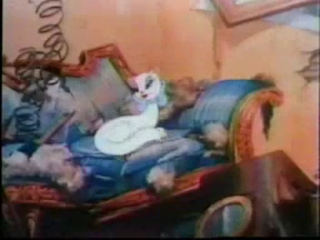
CONCLUDING THOUGHTS
This review proved highly difficult to write--I'd been working on it intermittently since the second of this month-- the amount of detail in the cartoon is so overwhelming, my eyes were spinning faster than the poor butler's. Every observation from me prompted a counter-observation from Kevin, which prompted a counter-counter observation from me. In the interest of time I won't go into all of them, but I would like to address Kevin's speculation that Bill Hanna and Joe Barbera were involved in this cartoon, and were in fact the uncredited directors.
It is certainly possible. Like so many MGM cartoons of this period, this is a transitional work, anticipating the later Tom and Jerrys in its wanton destruction, high-speed chases and slapstick takes. The alley cat, in appearance and manner, looks much like a forerunner of Butch, the black alley cat nemesis/sometime friend of Tom in later years. The scene of the alley cat nonchalantly and boorishly smoking a cigar reminded of one of several cartoons in which Tom and Butch were romantic rivals: Puss and Toots comes to mind.
Unlike the Tom and Jerrys, however, this cartoon makes me cringe, as it did when I first saw it some thirty years ago. Not that it's badly done--far from it. It's certainly one of the fastest and most slapstick cartoons Harman ever attempted, with its quick cuts and generous use of "smear" animation. But it suffers from a common fault of Harman's cartoons, the jarring juxtaposition of Disney-like realism with out-of-nowhere cartooniness.
In the beginning of The Alley Cat, the two principal characters move and behave very much like "real" cats, albeit slightly humanized, much in the same manner as Disney's The Aristocats. No sooner do the two cats meet, however, than they become more and more anthropomorphic, to the point of standing on two legs. The scene in which the pretty society cat pines for the alley cat on the balcony is comically out of place, as she shifts from very cat-like movements to very human gestures in a split-second. It prompted the same sort of nails-on-the-chalkboard feeling I had when I first saw Harman's Circus Daze; the realistically-rendered elephant, under attack by the fleas, suddenly looks as if it should be in a different cartoon, becoming very human-like as it stands on its hind legs and scratches with its front paws. Harman would set down certain "rules" for the behavior of his characters at the beginning of every cartoon, then gleefully (or carelessly) ignore them to suit the scene or the gag. Done right, the contrast between realism and cartooniness in Harman's work led to brilliance, as with Peace On Earth; more often, however, it led to laughable contradictions, as with the realistically rendered deer and the "rubber hose" fawn of Tales Of The Vienna Woods.
It seems as though Harman were in crisis at this point in his career, uncertain of which direction he wanted his cartoons to go. Wanting to be artistic, but feeling compelled to do slapstick, he opts for a little of both, and the results were both confusing and fascinating.
In The Alley Cat, this "one foot in reality" approach undercuts the cartoon a bit. Even though the characters are humanized and somewhat exaggerated, the cartoon nonetheless takes place in a world which seems to operate according to the normal rules of physics, as in the scene with the bulldog on the ceiling I wrote of earlier. The momentum could conceivably propel someone that high were they to move fast enough. Take a look at Donald O'Connor's "Make 'Em Laugh" sequence in Singin' In The Rain if you have any doubt--at one point the momentum of his leap enables him to walk halfway up the wall before he backflips down to earth again.
It unfortunately makes the alley cat's boorishness and destruction more intolerable (and difficult to watch) than they would have been in a less realistic cartoon--we know in a Tom and Jerry cartoon that no matter what damage they do to themselves and everything around them, things will be all right again in the next scene. Not here--one can't look at the destruction without imagining the thousands of dollars worth of repairs the place would need. (Hundreds of thousands in 2007 dollars). It's enough to give Donald Trump nightmares.
Interviews later in his life provide some insight into why Harman worked this way. Talking to Michael Barrier in the '70s, Harman lamented having to work solely on funny-animal cartoons, wishing he could have taken the medium further. His dream, he tells Barrier, would have been to get Orson Welles involved in the animation industry, which in his view would have elevated the animated film to a level of artistry that would have surpassed even the great Disney. (He could well have been right). Long after Harman's career was over, and Walt Disney had passed on, Harman dreamed of ways to upstage his old rival.
Certainly the best thing about this cartoon is the music, and Scott Bradley doesn't disappoint. The signature song here, That Old Feeling, is taken from an obscure musical, Vogues of 1938; for those who might be curious about the lyrics (since they're barely comprehensible when "sung" by the alley cat) Kevin has graciously provided them:
I saw you last night and got that old feeling When you came in sight I got that old feeling
The moment you came by I felt a thrill
And when you caught my eye
My heart stood still
Once again I seemed to have that old yearning
And I knew the spark of love was still burning
There'll be no new romance for me
It's foolish to start
For that old feeling is still in my heart
(repeat)
One of its composers seems to have had a penchant for obscure musicals. He'd already co-written Hold Everything, which by a coincidence possible only in Hollywood, provided the inspiration for one of Hugh Harman's earlier cartoons, Hold Anything: yes, none other than Lew Brown of DeSilva/Brown/Henderson fame. (Though he partnered with Sammy Fain for this particular number).
It's in the music, in fact, that this cartoon distinguishes itself from the majority of Harman's efforts; like Romeo In Rhythm the year before, this is an aggressively MGM cartoon, a companion piece of sorts to Romeo. The number is so good, and suits the cartoon so well, one can forgive its highly burlesqued rendition.
And the voice that warbled the number? As I said, it's not Clarence Nash, and if my memory and my ears had been functioning properly when I first heard it, it would have been apparent to me immediately. It's closer to the sound of the cat in Tex Avery's Ventriloquist Cat than anything even vaguely resembling Donald Duck. Jerry Beck settled the question once and for all, saying in a letter to Kevin:
It is not Clarence Nash in the MGM cartoon. That is for sure. Nash never did cartoons for anyone else except Disney. The voice in THE ALLEY CAT is radio actor Harry E. Lang who did Donald Duck like voices in several cartoons for MGM and Columbia.
It's probably just as well. Actually hiring Nash would only have reinforced the erroneous belief that Harman was a mere Disney imitator--and as I said in the beginning, he was very much his own man.
Tags: review/synopsis, The+Alley+Cat, Hugh+Harman, MGM
